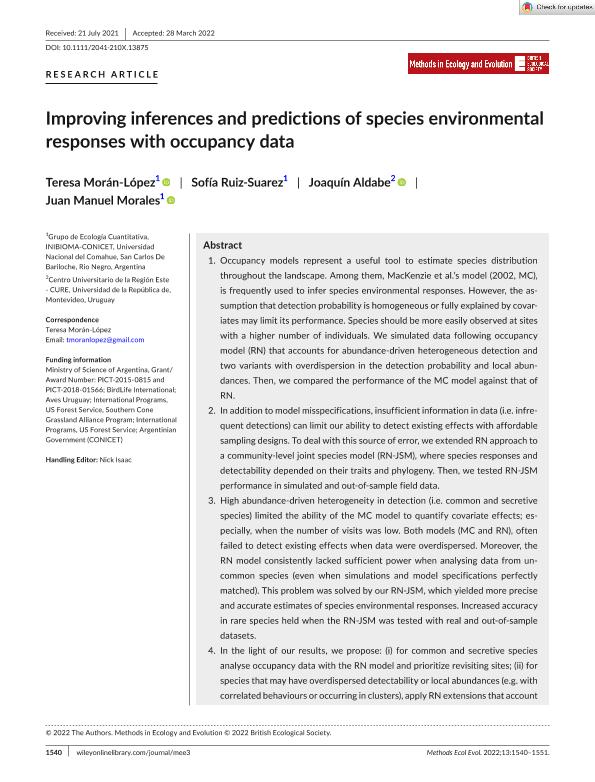Artículo
Improving inferences and predictions of species environmental responses with occupancy data
Fecha de publicación:
04/2022
Editorial:
Wiley
Revista:
Methods in Ecology and Evolution
ISSN:
2041-210X
Idioma:
Inglés
Tipo de recurso:
Artículo publicado
Clasificación temática:
Resumen
Occupancy models represent a useful tool to estimate species distribution throughout the landscape. Among them, MacKenzie et al.’s model (2002, MC), is frequently used to infer species environmental responses. However, the assumption that detection probability is homogeneous or fully explained by covariates may limit its performance. Species should be more easily observed at sites with a higher number of individuals. We simulated data following occupancy model (RN) that accounts for abundance-driven heterogeneous detection and two variants with overdispersion in the detection probability and local abundances. Then, we compared the performance of the MC model against that of RN. In addition to model misspecifications, insufficient information in data (i.e. infrequent detections) can limit our ability to detect existing effects with affordable sampling designs. To deal with this source of error, we extended RN approach to a community-level joint species model (RN-JSM), where species responses and detectability depended on their traits and phylogeny. Then, we tested RN-JSM performance in simulated and out-of-sample field data. High abundance-driven heterogeneity in detection (i.e. common and secretive species) limited the ability of the MC model to quantify covariate effects; especially, when the number of visits was low. Both models (MC and RN), often failed to detect existing effects when data were overdispersed. Moreover, the RN model consistently lacked sufficient power when analysing data from uncommon species (even when simulations and model specifications perfectly matched). This problem was solved by our RN-JSM, which yielded more precise and accurate estimates of species environmental responses. Increased accuracy in rare species held when the RN-JSM was tested with real and out-of-sample datasets. In the light of our results, we propose: (i) for common and secretive species analyse occupancy data with the RN model and prioritize revisiting sites; (ii) for species that may have overdispersed detectability or local abundances (e.g. with correlated behaviours or occurring in clusters), apply RN extensions that account for this extra-variation (e.g. Poisson-beta or zero-inflated models). Finally, (iii) for uncommon species (mean abundances <1), whenever possible, gather data at the community level and apply joint species modelling techniques.
Archivos asociados
Licencia
Identificadores
Colecciones
Articulos(INIBIOMA)
Articulos de INST. DE INVEST.EN BIODIVERSIDAD Y MEDIOAMBIENTE
Articulos de INST. DE INVEST.EN BIODIVERSIDAD Y MEDIOAMBIENTE
Citación
Morán López, Teresa; Ruiz Suarez, Sofia Helena; Aldabe, Joaquín; Morales, Juan Manuel; Improving inferences and predictions of species environmental responses with occupancy data; Wiley; Methods in Ecology and Evolution; 13; 7; 4-2022; 1540-1551
Compartir
Altmétricas




